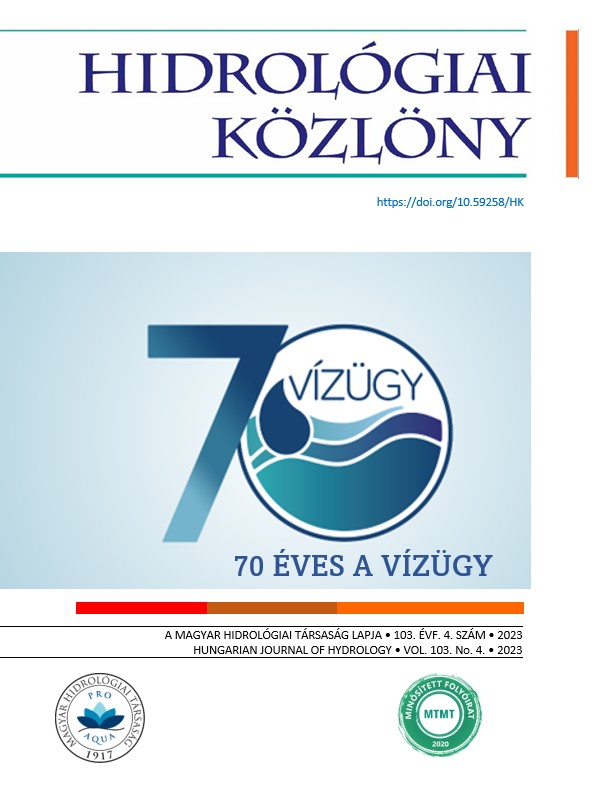The importance of the hydraulic conductivity in case of the impact assessment of gravel pits
Abstract
The evaporation of gravel pits is recharged from the groundwater. This surplus of the open surface compared to the covered area is a loss of water from the point of view of the groundwater balance, that results in modified flow conditions and the sinking of the groundwater level around the gravel pit both in operation and abandoned. The magnitude of this water level sinking – drawdown - is essentially influenced by the hydraulic conductivity. The hydraulic conductivity is one of the most uncertain parameters to estimate in the engineering and geological practice, as even within a given mining lot it may vary rather sharp from point to point, from layer to layer. But at the same time, it may be proven, that the effect of the hydraulic conductivity on the groundwater levels is significant: in case of a given type of soil the possible extreme values of the conductivity may result even a tenfold difference in drawdown. Summarizing the main methods to determine the hydraulic conductivity and comparing them from the point of view of gravel dredging, the aim of this paper is to call the attention on the importance of this parameter.
References
Farkas D., Farkas-Karay Gy., Hegedűs N. (2019). Szivárgási tényező laboratóriumi meghatározása szemel-oszlási görbe és kisminta-modell felhasználásával. Hidrológiai Közlöny, 99. évf. 4. sz. pp. 42-51.
J. F. Devlin Software http://www.people.ku.edu/~jfdevlin/Software.html
Juhász J. (2002). Hidrogeológia. Akadémiai Kiadó, Budapest. p. 1176.
Kammerer, G., Loiskaindl, W. (2008). Bodenphysik. Universität für Bodenkultur Wien.
Kasenow, M. (2002). Determination of hydraulic conductivity from grain size analysis. Water Resources Publications, Highlands Ranch, CO, USA
Kézdi Á., Markó I. (1974). Földművek. Víztelenítés. Műszaki Könyvkiadó, Budapest. p. 298.
Kovács Gy. (1972). A szivárgás hidraulikája. Akadémiai Kiadó, Budapest. p. 535.
Mérnöki Kézikönyv (1981). Mérnöki Kézikönyv 1. kötet. szerk: Palotás L. Műszaki Könyvkiadó, Budapest. p. 926.
Mérnöki Kézikönyv (1957). Mérnöki Kézikönyv 2. kötet, szerk: Palotás L. Műszaki Könyvkiadó, Budapest. p. 1042.
MSZ 15221 (1969). Vízépítés. Szivárgások vizsgálata építményeket határoló talajrétegekben.
Nagy L. (2008a). Finomszemcsés talajok áteresztőképessége. Közúti és Mélyépítési Szemle 58. évf. 5-6. sz. pp. 33-40.
Nagy L. (2008b). Jól graduált talajok áteresztőképességi együtthatója. Közúti és Mélyépítési Szemle 58. évf. 8. sz. pp. 23-27.
Odong, J. (2007). Evaluation of empirical formulae for determination of hydraulic conductivity based on grain-size analysis. Journal of American Science, 3(3). pp. 54-60.
Tompa L. (1982). A kavicsbányászat története Magyarországon. Földtani Kutatás XXV. évf. 2. sz. pp. 69-76.
Varga I., Csoma R. (1995). Környezeti áramlástantan. Felszíni és felszín alatti vízterek. Tanszéki sokszorosí-tású előadási jegyzet. Budapesti Műszaki Egyetem Vízépítési Tanszék
Vienken, Th. (2010). Critical evaluation of vertical high resolution methods for determining hydraulic con-ductivity. Dissertation. Eberhard Karls Universität Tübingen.
Vízrajzi Atlasz 11. kötet (1971). Duna. Vízrajzi Atlasz 11. kötet. Vízgazdálkodási Tudományos Kutató Inté-zet. Budapest.
Vukovic, M., Soro, A. (1992). Determination of hydraulic conductivity of porous media from grain-size com-position. Water Resources Publications, Littleton, Colorado, USA
Copyright (c) 2023 Rózsa Csoma

This work is licensed under a Creative Commons Attribution-NonCommercial-ShareAlike 4.0 International License.




